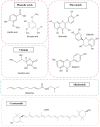Unconventional Edible Plants of the Amazon: Bioactive Compounds, Health Benefits, Challenges, and Future Trends
- PMID: 39335854
- PMCID: PMC11431067
- DOI: 10.3390/foods13182925
Unconventional Edible Plants of the Amazon: Bioactive Compounds, Health Benefits, Challenges, and Future Trends
Abstract
The pursuit of an improved quality of life is a major trend in the food market. This is driving the reformulation of the industry's product portfolio, with the aim of providing nourishment while also contributing to beneficial health metabolic processes. In this context, the use of local biodiversity and the recovery of the traditional knowledge associated with the consumption of vegetables that grow spontaneously in nature emerge as more sustainable and nutritionally adequate concepts. The Amazon region is known for its abundant biodiversity, housing numerous unconventional food plants whose nutritional and biological properties remain unknown due to a lack of research. Among the different species are Xanthosoma sagittifolium, Acmella oleracea, Talinum triangulare, Pereskia bleo, Bidens bipinnata, and Costus spiralis. These species contain bioactive compounds such as apigenin, syringic acid, spilanthol, and lutein, which provide various health benefits. There are few reports on the biological effects, nutritional composition, bioactive compounds, and market prospects for these species. Therefore, this review provides an overview of their nutritional contribution, bioactive compounds, health benefits, and current market, as well as the use of new technologies that can contribute to the development of functional products/ingredients derived from them.
Keywords: Amazon plants; biological activities; edible plants; green leaves; phenolic compounds; phytochemicals.
Conflict of interest statement
The authors declare that they have no conflicts of interest.
Figures


Similar articles
-
Nutritional composition, phenolic compounds and biological activities of selected unconventional food plants.Food Res Int. 2024 Sep;191:114643. doi: 10.1016/j.foodres.2024.114643. Epub 2024 Jun 22. Food Res Int. 2024. PMID: 39059900 Review.
-
Culinary and nutritional value of edible wild plants from northern Spain rich in phenolic compounds with potential health benefits.Food Funct. 2020 Oct 21;11(10):8493-8515. doi: 10.1039/d0fo02147d. Food Funct. 2020. PMID: 33034610 Review.
-
Five undervalued edible species inherent to autumn-winter season: nutritional composition, bioactive constituents and volatiles profile.PeerJ. 2021 Nov 23;9:e12488. doi: 10.7717/peerj.12488. eCollection 2021. PeerJ. 2021. PMID: 34900422 Free PMC article.
-
A Review on Bioactive Compounds, Ethnomedicinal Importance and Pharmacological Activities of Talinum triangulare (Jacq.) Willd.Chem Biodivers. 2023 Dec;20(12):e202301079. doi: 10.1002/cbdv.202301079. Epub 2023 Nov 15. Chem Biodivers. 2023. PMID: 37867157 Review.
-
Agronomic Cultivation, Chemical Composition, Functional Activities and Applications of Pereskia Species - A Mini Review.Curr Med Chem. 2019;26(24):4573-4584. doi: 10.2174/0929867325666180926151615. Curr Med Chem. 2019. PMID: 30259803 Review.
References
-
- FAO. IFAD. PAHO. UNICEF. WFP . Latin America and the Caribbean—Regional Overview of Food Security and Nutrition 2023. FAO; Santiago, Chile: 2023.
-
- Roberts D.P., Mattoo A.K. Sustainable Crop Production Systems and Human Nutrition. Front. Sustain. Food Syst. 2019;3:72. doi: 10.3389/fsufs.2019.00072. - DOI
-
- Banwo K., Olojede A.O., Adesulu-Dahunsi A.T., Verma D.K., Thakur M., Tripathy S., Singh S., Patel A.R., Gupta A.K., Aguilar C.N., et al. Functional Importance of Bioactive Compounds of Foods with Potential Health Benefits: A Review on Recent Trends. Food Biosci. 2021;43:101320. doi: 10.1016/j.fbio.2021.101320. - DOI
-
- Kinupp V.F., de Barros I.B.I. Riqueza de Plantas Alimentícias Não-Convencionais Na Região Metropolitana de Porto Alegre, Rio Grande Do Sul. Rev. Bras. Biociências. 2007;5:63–65.
-
- Milião G.L., de Oliveira A.P.H., Soares L.D.S., Arruda T.R., Vieira É.N.R., Leite Junior B.R.d.C. Unconventional Food Plants: Nutritional Aspects and Perspectives for Industrial Applications. Futur. Foods. 2022;5:100124. doi: 10.1016/j.fufo.2022.100124. - DOI
Publication types
Grants and funding
- 406820/2018-0/National Council for Scientific and Technological Development
- 142316/2019-9/National Council for Scientific and Technological Development
- 2020/08761-4/Fundação de Amparo à Pesquisa do Estado de São Paulo
- 001/Coordenação de Aperfeicoamento de Pessoal de Nível Superior
- 001/Fundação de Amparo à Pesquisa do Estado do Amazonas
LinkOut - more resources
Full Text Sources

